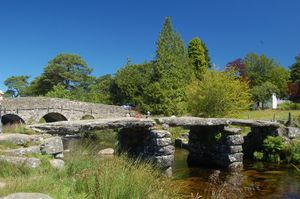Cëlac
The River Cëlac (olg. cël-lac [ˈt͡ʃɛlak] ‘bending stream’) is one of the two great rivers of Belkondíl, next to the Brethan, and a central landmark in Olgish culture and legend.
Course
The Cëlac rises on the slope of Mt. Almin above the Valley of Parka in the Reknayan Mountains and takes many minor tributaries as it follows the Black Road south, entering Belkondíl as it emerges from Cëlac's Gate between the City of Lágon and the Jeskíl-Srejk. Already a major albeit relatively narrow body of water at this point, its volume is increased considerably in the subsequent confluences with the rivers Äroïn and Nellac on its course south. It is uncrossable by ford from Fáda, although still narrow enough to allow for a series of clapper bridges traversing it south of the village, the first major bridge being located at Soskilón; the river is fully navigable by both rafts and riverboats south of Tinnas. This part of its course mainly follows the trough east of the Olgish Highlands, avoiding the higher moorlands and marshes most of the lower Nellac is passing through. Off the southern tip of the highlands, the Cëlac traverses Gliron and joins the White Sea and a long estuary, the Cëlacmouth.
Cultural Significance
On its course south, the Cëlac passes many major landmarks of great significance in Olgish history and mythology, including the cities of Lágon, Soskilon, and Gëlenem and the Hill of Ortûlék itself. Early on in Olgish religion, it was considered one of Awol’s major marks on the world and one of the three rivers that originally traced the tears of Kána into the ocean (the others being Brethan and Besokan). When the Olgish tribes disperse over Belkondíl, the two major groupings are named after the rivers they settle by, dividing the Olgish peoples into those of the Brethan, the later Brethanians of the Mairn, and those of the Cëlac, the later Olgs proper.
The Cëlac is mentioned most frequently of all geographical features of Belkondíl in Olgish literature and praised either for its visual beauty, its agricultural and spiritual significance, or its close connection to the Olgish people. North of Soskilón, it crosses the forest of Kali-Tonin, a mere three days' travel east of the Brethan's well at Lemmi-Dirith within the same woodlands, and a common motif in praise literature concerns this common origins if both rivers, effectively framing the Brethan as having sprung from the Cëlac itself. Its convenient course as a nearly straight line traversing Belkondíl north-to-south has also contributed to the Cëlac's role in transportation, both in rafts and boats on the river itself and following its course on land. Especially journeys from Soskilón to Lágon follow the Cëlac from earliest history, and the first Imperial Road of Lécaron, Niom I Alôr, follows the course of the Cëlac all through Belkondíl, from Gëlenem to Lágon.
